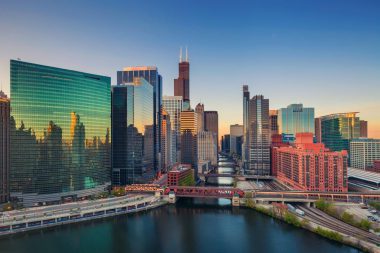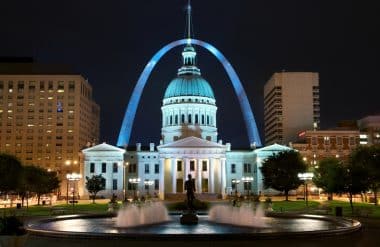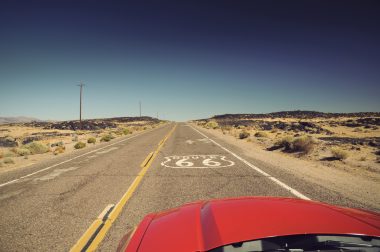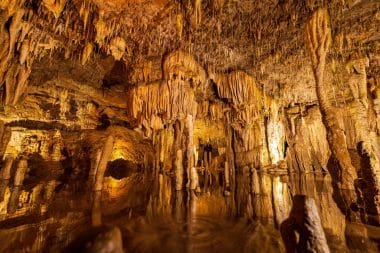A drive along the legendary Route 66 offers adventure, a touch of nostalgia and plenty of photo opportunities. This historic journey manages the balancing act between impressions of our modern busy world and the time of departure in the land of unlimited opportunities. “Go West!” was the motto for many farmers and soldiers of fortune in the first half of the 20th century. Route 66 was one of the first paved cross-links they could use for this purpose. With covered wagons or motorized, they made it from Lake Michigan in the state of Illinois to the promising west coast in California.
The single-track and winding route was almost 4,000 km long. Today, this original route is called the “Mother Road”. It is not completely contiguous, but we as travelers are happy to accept the bypasses. Heavy traffic and rush hour traffic has long used the straighter, multi-lane interstate highways. Lucky for the tourist! Thus, on the “mother of all American roads”, you can discover the diversity of the country and the eventful history of its inhabitants in peace.
Increased heartbeat at the starting point and varied scheduling

A slightly accelerated pulse and a lot of anticipation set in at the starting point. The sign with the inscription “Begin Historic Route 66” stands in Chicago in the middle of high-rise buildings on East Adams Street between Michigan and Wabash Avenues. The sign hangs high up so as not to fall into the hands of enthusiastic souvenir hunters. The exact starting point was moved several times within two blocks when one-way traffic was introduced in several streets years ago. Before our road trip, there is already a lot to see in Chicago, whether it’s the luxurious Magnificent Mile, a view from the observation deck of the John Hancock skyscraper or a performance in one of the numerous theaters. From our own hotel accommodation or from the car rental office, we drive towards Cicero on the day of departure and automatically merge onto Route 66.
The duration of the tour organized or planned by the tour operator can vary greatly. If you only have limited time and resources available, you can complete one of the interesting sections. The path from Seligman to the west is particularly popular. For the whole route from Chicago to Los Angeles , you can calculate about 10 days, depending on the number of detours and breaks. A good idea is for two drivers to take turns. After all, the road trip leads through eight states and the road winds its way up to an altitude of over 2,000 meters in New Mexico and Arizona . So the project is not a piece of cake. For Chicago and Los Angeles, no matter in which direction the route is completed, at least one full day each should be planned for sightseeing and acclimatization.
Route 66 – From Illinois to the Land of the Red Man
Leaving the vibrant metropolitan area of Chicago in a southwesterly direction, we pass the city of Cicero by car or motorcycle. This is where Al Capone moved his criminal empire to escape the Chicago police departments. Capone liked to go to the casino in Joliet, which we cross after an hour’s drive from Chicago. Route 66 now leaves densely populated area. Time passes more slowly as farms, vast wheat fields and idyllic villages pass by. We are located in one of the most fertile grain-growing and livestock regions in the United States. In Springfield, the capital of Illinois, there is a lot to learn about President Abraham Lincoln, his former home with the address “413 South Eighth Street” can be visited.

The next stage leads across the wide Mississippi to St. Louis in the state of Missouri. The population of this city is half white and half African-American. The “Gateway Arch” memorial near the river is worth seeing, with a 192-metre-high walk-in archway and an underground visitor centre. On gently rising hills, the journey continues towards and through Oklahoma, in German: “The Land of the Red Man”. This is where the casual gliding on the asphalt begins with little oncoming traffic.
We see water towers on the roadside, steppe landscape, fantastic sunsets and listen to country songs on the radio, to name just a few of the atmospheric impressions. After the encounter with the restored blue whale of Catoosa, a landmark of US Highway 66, Oklahoma City greets. On the Bricktown Canal, city tours are offered with water taxis. If you prefer the fast-paced, the Frontier City amusement park with its fast roller coasters and varied live shows is the right place for you.
Cadillacs rammed into the ground and desert highlands
The 58-meter-high “Groom Cross” is the first sight on the dry plateau in the state of Texas. Steve Thomas has erected the cross as a contrast to the many erotic display boards on the interstate. A little later, a few kilometers west of Amarillo, we reach not only the geographical center of the original Route 66, but also the famous Cadillac Ranch, which has already been featured in several music videos. This is a field with half-buried tailfin models from the 50s. The artist group Ant Farm from San Francisco wanted to use this artwork to visualize profound messages about the freedoms that the automobile produced. Visitors are encouraged to leave their own traces of paint on the graffiti-painted Cadillacs.
At the town of Glenrio, the border to New Mexico and a new time zone (Mountain Time) is crossed. Glenrio is almost deserted, the town was deprived of its economic basis with the construction of the Interstate. After continuing our journey, we reach the fast-growing, largest city in New Mexico, Albuquerque. It was founded as a Spanish colony in the desert highlands. The old town is still adorned with some historic clay buildings. Further west comes the transition to the state of Arizona. Established in 1949, the Yellowhorse Indian Trading Post is a recommended stop for original souvenirs.
From the high mountains down to the city of angels

We reach Flagstaff. This winter sports resort at 2106 meters is called the “Gateway to the Grand Canyon”. The surrounding area was shaped by volcanoes. A detour from here to the Grand Canyon National Park to the north is possible. The distance is 120 km, plus the return trip. Closer attractions include Walnut Canyon, 15 km away, and Barringer meteorite crater. The next destination on the route is a must: the town of Seligman. The town calls itself the “birthplace of the historic Route 66” and is a true pilgrimage town for fans. Seligman’s hairdresser, who successfully fought against the decline of his town, has long since transformed his salon into a flourishing souvenir shop.
Through breathtaking landscapes, over the winding Sitgreaves Pass and past the old gold mining town of Oatman, we reach the Colorado River and finally the state of California. In Needles, we’ll have to adapt our clocks to the Pacific time zone. The bottle garden in “Elmer Long’s Bottle Tree Ranch” is perhaps the last personal, uncrowded and historic-looking sight before the modern and fast-paced world slowly envelops us again with the tentacles of a city of millions. Route 66 technically ends west of Los Angeles at Santa Monica’s sunny piers, but not before it has left a lasting impression on every driver and passenger.
General information
Historic Route 66 was officially established in 1926 and originally stretches from Chicago, Illinois, to Santa Monica, California, for approximately 2,448 miles (approximately 3,940 kilometers). It crosses eight states: Illinois, Missouri, Kansas, Oklahoma, Texas, New Mexico, Arizona and California.
Meaning
Route 66 was an important trail for those who moved west during the Dust Bowl in the 1930s, and it has gained an almost mythical status in American pop culture, immortalized through literature, music, and television.
Sights

There are numerous historical and cultural attractions along Route 66, including:
- The Start in Chicago: Start at the official start of Route 66 in Chicago and explore the metropolis.
- Meramec Caverns in Missouri: A limestone cave system that is said to have served as a hideout for the notorious outlaw Jesse James.
- Cadillac Ranch in Texas: An artistic installation consisting of Cadillac cars half-buried in the ground.
- The Blue Whale of Catoosa in Oklahoma: An iconic water attraction and a popular photo stop.
- Petrified Forest National Park in Arizona: Known for its large amounts of petrified wood and its picturesque desert landscapes.
- Santa Monica Pier in California: The official final destination of Route 66, a great place to experience the Pacific.
Activities
- Road Trips: Route 66 is the ultimate road trip experience that allows you to experience the diversity of American landscapes and cultures.
- Photography: The street offers countless opportunities for impressive photographs of classic American scenes, historic buildings, and natural beauty.
- Local cuisine: Sample the diverse culinary offerings along the route, from classic diner dishes to authentic regional specialties.
Cultural significance
Route 66 represents freedom, adventure, and the search for a better life, which has made it an enduring symbol of American dreams and values. The conservation efforts help to keep this heritage alive for future generations.
Journey
Although many sections of the original Route 66 have been replaced by the modern Interstate Highways, the historic routes are well-marked and accessible to travelers who want to experience historic America.
This information provides a comprehensive overview of Route 66, ideal for an online travel magazine that wants to educate its readers about this legendary American road.


